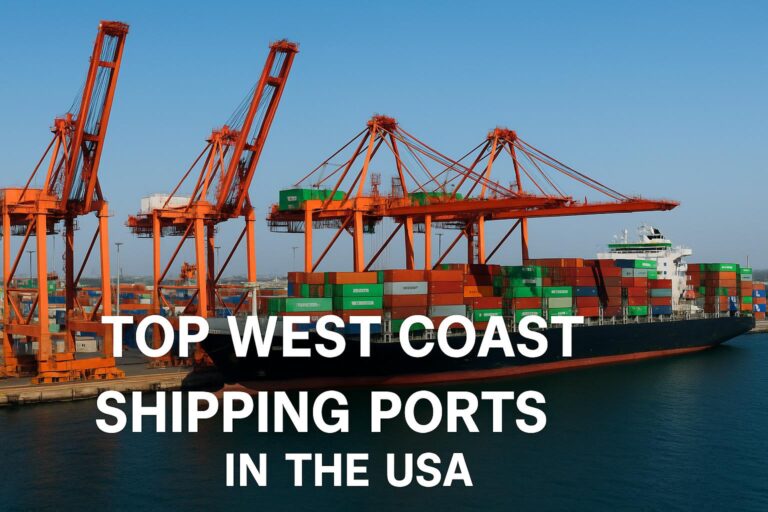The top West Coast shipping ports in the USA play a vital role in supporting international trade, facilitating container shipping, and driving economic growth through their strategic location along the Pacific Ocean. From Los Angeles to Seattle-Tacoma, these ports handle millions of twenty-foot equivalent units (TEUs) annually and serve as critical links in global supply chains.
Thanks to their efficient operations, advanced container terminals, and direct access to global markets, these ports support both regional and global trade, while contributing significantly to the national economy. Whether moving bulk cargo, automobiles, or high-value electronics, West Coast ports remain a key hub for maritime commerce.

Importance of West Coast Ports in North America
The West Coast ports serve as the primary entry point for trans-Pacific shipments from Asia, including China, South Korea, Japan, and Vietnam. Compared to East Coast ports, they offer shorter transit times, better access to Asian trade lanes, and well-integrated logistics infrastructure.
Key highlights:
Vital gateways to global markets
Strategic location for trans-Pacific trade
Home to the busiest container ports in the U.S.
Ports handle bulk commodities, project cargo, and container ships
Central to maritime operations and economic activity
These ports in the United States are also instrumental in job creation, innovation, and environmental sustainability, investing in cutting-edge technologies to support seamless operations and ensure environmental stewardship.
Port of Los Angeles: The Busiest Container Port in the U.S.
Located in San Pedro Bay, the Port of Los Angeles is the busiest container port in the country and a global powerhouse for ocean freight. It processes more than 9 million TEUs annually, playing a vital role in handling cargo from Asia to North America.
Highlights:
Over 25 container terminals and cargo terminals
Advanced infrastructure for container ships and Ro-Ro vessels
A critical player in the global trade network
Strong focus on environmental stewardship and sustainability
Extensive customs support and smooth operations
As a public asset, the Port of Los Angeles is a key hub for global supply chains, providing seamless connectivity to railroads, highways, and inland distribution centers. Its strategic importance cannot be overstated.
Port of Long Beach: Southern California's Logistics Powerhouse
Sharing the San Pedro Bay with its neighbor, the Port of Long Beach ranks second nationally in container volume and complements the Port of Los Angeles through specialized services.
Key features:
Handles over 8.1 million TEUs annually
Leader in cutting-edge technologies and green port initiatives
Operates specialized container terminals and private terminals
Manages significant amounts of raw materials, automobiles, and bulk cargo
The Long Beach port plays a central role in ensuring smooth operations for international shippers. Its proximity to inland markets and major rail hubs ensures quick delivery to final destinations across the U.S.
Port of Oakland: Northern California's Premier Container Port
The Port of Oakland is the primary maritime gateway for Northern California, serving the San Francisco Bay region and inland agricultural zones. As one of the busiest ports on the West Coast, Oakland handles millions of tons of cargo annually, including agricultural products, bulk commodities, and high-value goods.
Key Strengths:
Handles over 2.4 million TEUs each year
Equipped with modern container terminals and cold-chain logistics
Strong links to trans-Pacific trade and global markets
Critical for exporting raw materials, wine, fruit, and vegetables
This port’s strategic location near California’s Central Valley enables fast export of perishables, while its rail and highway network connects directly to the Midwest and East Coast. Oakland’s commitment to environmental sustainability has made it a leader in clean maritime operations.
Port of Seattle: Key Hub in the Pacific Northwest
The Port of Seattle is part of the Seattle-Tacoma alliance (Northwest Seaport Alliance), which together ranks among the top five container ports in North America. The Seattle terminal is known for its capacity to handle both container ships and bulk cargo, making it a versatile facility.
What Sets Seattle Apart:
Direct service to over 20 international ports
Excellent rail access to Canada and the U.S. interior
A growing center for project cargo and tech components
Supports international trade and regional economic growth
Seattle’s port plays an essential role in regional and global trade, serving industries such as aerospace, electronics, seafood, and energy. It’s a bustling hub of maritime commerce that continues to expand through cutting-edge technologies and smart port infrastructure.
Port of Tacoma: Ro-Ro and Heavy Machinery Specialist
The Port of Tacoma, located just south of Seattle, specializes in Ro-Ro (roll-on/roll-off) operations and heavy machinery. As part of the Seattle-Tacoma port system, it manages a large share of the alliance’s container volume and is crucial for handling bulk cargo and industrial equipment.
Highlights:
Over 2 million TEUs moved annually
Focused on efficient operations and quick turnarounds
Strong handler of automobiles, trucks, and machinery
Excellent access to domestic markets via truck and rail
Thanks to its direct access to the inland U.S. and its emphasis on seamless operations, Tacoma is ideal for businesses importing project cargo and oversized shipments that require special handling.
Port of San Diego: A Strategic but Niche Port
The Port of San Diego plays a more specialized role compared to larger West Coast ports, focusing on bulk cargo, project cargo, and automotive imports. Although it handles less container volume, it remains a critical player in the region.
Port Capabilities:
Two primary cargo terminals
Major hub for automobile imports from Asia
Strong cross-border connection with Mexico
Handles heavy machinery and unique shipments
Its strategic location near the U.S.-Mexico border and its reputation for smooth operations make San Diego ideal for customized logistics projects and final destination delivery in Southern California.
Comparing West Coast Ports with East Coast and Gulf Coast Ports
East Coast ports like New York and Charleston are expanding due to Suez Canal access, while West Coast ports still dominate trans-Pacific trade because of their proximity to Asia. Gulf Coast ports mainly focus on energy exports and bulk goods.
| Region | Key Ports | Avg. Transit Time from China | Main Cargo |
|---|---|---|---|
| West Coast | Los Angeles, Long Beach, Oakland, Seattle-Tacoma | 14–20 days | Electronics, eCommerce, Automobiles |
| East Coast | New York, Savannah, Charleston | 25–35 days | Retail, Consumer Goods |
| Gulf Coast | Houston, New Orleans | 30–40 days | Energy, Bulk Cargo |
Key Comparison Points:
West Coast: Shorter transit from Asia, advanced container facilities
East Coast: Expanding due to Suez Canal access, deeper channels
Gulf Coast: Energy-related cargo, lower congestion
Despite competition from Georgia Ports Authority and others, West Coast ports remain irreplaceable in the global trade landscape due to their capacity, strategic importance, and role in economic activity.
For more detailed guidance on shipping from China to the USA, explore these resources:

Conclusion: Choosing the Right West Coast Port for Your Shipping Needs
The top West Coast shipping ports in the USA form the backbone of American international trade with Asia and the Pacific Rim. With state-of-the-art container terminals, deepwater access for container ships, and well-developed logistics networks, ports like Los Angeles, Long Beach, Oakland, and Seattle-Tacoma continue to lead in container volume, economic impact, and strategic importance.
Whether you’re shipping agricultural products, bulk commodities, heavy machinery, or eCommerce goods, selecting the right container port can improve delivery times, reduce costs, and ensure seamless operations. For companies looking to scale their supply chains across North America, partnering with experienced freight forwarders and choosing the most suitable port’s contribution to your route is essential for long-term success in global supply chains.
Frequently Asked Questions (FAQs)
What is the largest shipping port on the West Coast of the USA?
The Port of Los Angeles is the largest, handling over 9 million TEUs annually. It is located in San Pedro Bay and plays a leading role in trans-Pacific trade.
How do West Coast ports compare to East Coast ports?
West Coast ports offer shorter transit times from Asia and superior access to inland U.S. markets. However, East Coast ports like New York and Savannah are growing rapidly thanks to expanded access via the Suez Canal.
Which ports on the West Coast are best for Ro-Ro or bulk cargo?
The Port of Tacoma specializes in Ro-Ro and heavy industrial shipments, while San Diego is known for project cargo and automobile imports.
Do these ports contribute significantly to the U.S. economy?
Yes. Ports in the United States contribute to job creation, economic growth, and maritime commerce while supporting the movement of goods through global trade routes.
What is a twenty-foot equivalent unit (TEU)?
A TEU is a standard unit of measurement in container shipping, representing the dimensions of a 20-foot shipping container. It’s used to quantify container volume and port capacity.
Which West Coast port is best for shipping from China?
The Port of Los Angeles and the Port of Long Beach are the top choices for importers shipping from China. Together, they handle over 17 million TEUs annually and offer the fastest transit times for trans-Pacific trade.
Are West Coast ports cheaper than East Coast ports for shipments from China?
Yes, in most cases. Shipping from China to the U.S. West Coast is typically faster and more cost-effective due to shorter transit times compared to East Coast routes, which often add 7–10 extra days via the Panama or Suez Canal.


